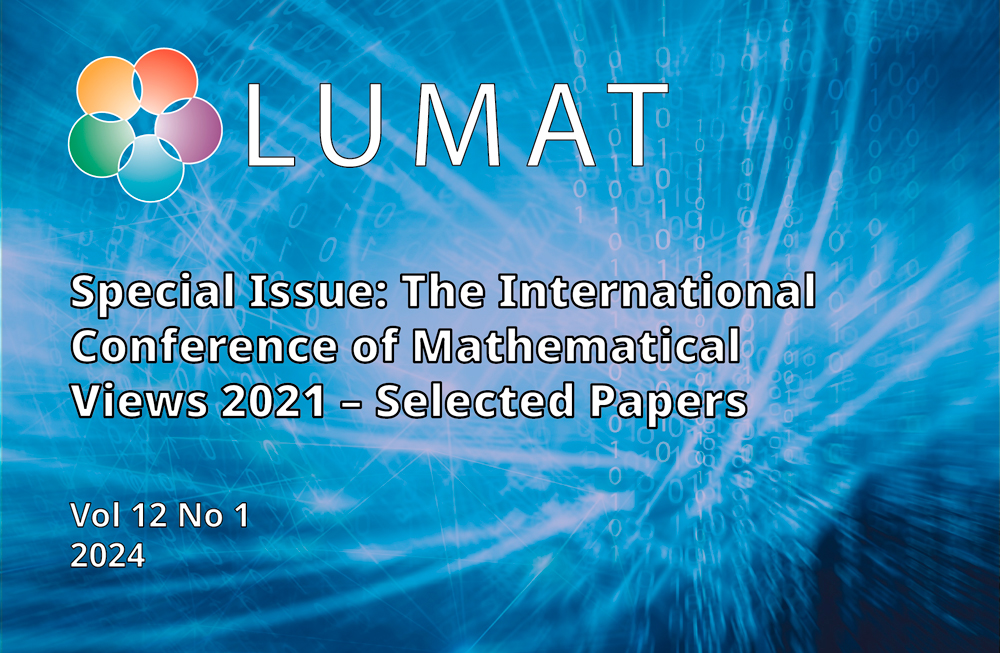Characterizing students’ beliefs about mathematics as a discipline
DOI:
https://doi.org/10.31129/LUMAT.12.1.2113Keywords:
beliefs about mathematics, mathematics-related beliefs, middle school, Primary students, lower secondary school students, literature reviewAbstract
To fully possess mathematical competence and to understand its relevance, importance and aesthetics, it is essential to be aware of aspects of mathematics not only as a school subject but also as a scientific discipline. In a systematic literature review, the theoretical characterization of compulsory school students’ beliefs about mathematics as a discipline is investigated, as well as the empirical tendencies in the nature of their actual beliefs. Furthermore, the valuation of these beliefs is addressed. The 18 included studies demonstrate a clear pattern in applying a dualistic/relativistic spectrum when characterizing and analysing students’ beliefs about mathematics as a discipline, with students generally possessing dualistic beliefs, which is in contrast to what is favourable to their learning.
References
Note: Studies included in the systematic review are indicated by an asterisk (*).
*Borasi, R. (1993). The invisible hand operating in mathematics instruction: Students’ conceptions and expectations. Problem posing: Reflections and applications, 83–91.
Dionne, J. J. (1984). The perception of mathematics among elementary school teachers. Paper presented at the Proc. 6th Annual Meeting of the North American Chapter of the Int. Group for the Psychology of Mathematics Education.
Ernest, P. (1989). The impact of beliefs on the teaching of mathematics. In P. Ernest (Ed.), Mathematics teaching : the state of the art (pp. 249–254). Falmer.
*Ernest, P. (2015). The social outcomes of learning mathematics: Standard, unintended or visionary? International Journal of Education in Mathematics, Science and Technology, 3(3), 187–192. https://doi.org/10.18404/ijemst.29471
Furinghetti, F., & Pehkonen, E. (2002). Rethinking Characterizations of Beliefs. In G. C. Leder, E. Pehkonen, & G. Törner (Eds.), Beliefs: A Hidden Variable in Mathematics Education? (pp. 39–58). Kluwer. https://doi.org/10.1007/0-306-47958-3_3
*Garofalo, J. (1989). Beliefs and their influence on mathematical performance. The Mathematics Teacher, 82(10), 502–505. https://doi.org/10.5951/mt.82.7.0502
*Gattermann, M., Halverscheid, S., & Wittwer, J. (2012). The relationship between self-concept and epistemological beliefs in mathematics as a function of gender and grade. Proceedings of PME 36, 2, 251–258.
*Grady, M. (2018). Students’ conceptions of mathematics as sensible: Towards the SCOMAS framework. The Journal of Mathematical Behavior, 50, 126–141. https://doi.org/10.1016/j.jmathb.2018.02.004
Green, T. F. (1971). The Activities of Teaching. McGraw-Hill.
*Grevholm, B. (2011). Norwegian upper secondary school students’ views of mathematics and images of mathematicians. Paper presented at the Current state of research on mathematical beliefs XVI. Proceedings of the MAVI-16 Conference.
*Grigutsch, S. (1998). On pupils’ views of mathematics and self-concepts: developments, structures and factors of influence. In E. Pehkonen & G. Törner (Eds.), The state-of-art in mathematics-related belief research : results of the MAVI activities (pp. 169–197). Department of Teacher Education, University of Helsinki.
*Grootenboer, P. (2003). The Affective Views of Primary School Children. International Group for the Psychology of Mathematics Education, 3, 1–8.
*Grouws, D. A. (1996). Student Conceptions of Mathematics: A Comparison of Mathematically Talented Students and Typical High School Algebra Students. Paper presented at the Annual Meeting of the American Educational Research Association, New York, NY.
*Halverscheid, S., & Rolka, K. (2006). Student beliefs about mathematics encoded in pictures and words. In J. Novotná, H. Moraová, M. Krátka & N. Stehlíková (Eds.), Proceedings 30th Conference of the International Group for the Psychology of Mathematics Education, Vol. 3 (pp. 233–240). PME
*Jankvist, U. T. (2015). Changing students' images of "mathematics as a discipline". Journal of Mathematical Behavior, 38, 41–56. https://doi.org/10.1016/j.jmathb.2015.02.002
*Kloosterman, P. (1996). Students’ beliefs about knowing and learning mathematics: Implications for motivation. Motivation in mathematics, 131–156.
*Kloosterman, P. (2002). Beliefs about Mathematics and Mathematics Learning in the Secondary School: Measurement and Implications for Motivation. In G. C. Leder, E. Pehkonen, & G. Törner (Eds.), Beliefs: A Hidden Variable in Mathematics Education? (pp. 247–270). Kluwer. https://doi.org/10.1007/0-306-47958-3_15
* McDonough, A. (1998). Young children's beliefs about the nature of mathematics. In A. Olivier & K. Newstead (Eds.), Proceedings of the 22nd Conference of the International Group for the Psychology of Mathematics Education (Stellenbosch, South Africa, July 12-17, 1998). (Vol. 3, pp. 263–270). University of Stellenbosch.
McDonough, A., & Sullivan, P. (2014). Seeking insights into young children's beliefs about mathematics and learning. Educational Studies in Mathematics, 87(3), 279–296. https://doi.org/10.1007/s10649-014-9565-z
Niss, M., & Højgaard, T. (2011). Competencies and mathematical learning : ideas and inspiration for the development of mathematics teaching and learning in Denmark: Roskilde University, Department of Science, Systems and Models.
Niss, M., & Højgaard, T. (2019). Mathematical competencies revisited. Educational Studies in Mathematics, 102(1), 9–28. https://doi.org/10.1007/s10649-019-09903-9
Oaks, A. B. (1989). The effects of the interaction of conception of mathematics and affective constructs on college students in remedial mathematics. Unpublished doctoral dissertation, University of Rochester. Rochester, NY.
Op't Eynde, P., de Corte, E., & Verschaffel, L. (2002). Framin Students' Mathematics-Related Beliefs. A Quest for Conceptual Clarity and a Comprehensive Categorization. In G. C. Leder, E. Pehkonen, & G. Törner (Eds.), Belief: A Hidden Variable in Mathematics Education? (pp. 13–38). Kluwer. https://doi.org/10.1007/0-306-47958-3_2
Schoenfeld, A. H. (1985). Mathematical problem solving. Academic Press. https://doi.org/10.1016/C2013-0-05012-8
*Schoenfeld, A. H. (1989). Explorations of Students' Mathematical Beliefs and Behavior. Journal for Research in Mathematics Education, 20(4), 338–355. https://doi.org/10.2307/749440
*Schoenfeld, A. H. (1992). Learning to think mathematically: Problem solving, metacognition, and sense making in mathematics. In Handbook of research on mathematics teaching and learning: A project of the National Council of Teachers of Mathematics. (pp. 334–370). Macmillan. https://doi.org/10.1177/002205741619600202
Skemp, R. R. (1976). Relational understanding and instrumental understanding. Mathematics teaching, 77(1), 20–26.
*Spangler, D. A. (1992). Assessing students' beliefs about mathematics. The Arithmetic Teacher, 40(3), 148–152. https://doi.org/10.5951/at.40.3.0148
*Underhill, R. (1988). Focus on Research into Practice in Diagnostic and Prescriptive Mathematics: Mathematics Learners' Beliefs: A Review. Focus on learning problems in mathematics, 10(1), 55–69.
Williams, S. R., & Leatham, K. R. (2017). Journal quality in mathematics education. Journal for Research in Mathematics Education, 48(4), 369–396. https://doi.org/10.5951/jresematheduc.48.4.0369
Downloads
Published
How to Cite
Issue
Section
Categories
License
Copyright (c) 2024 Maria Kirstine Østergaard

This work is licensed under a Creative Commons Attribution 4.0 International License.










